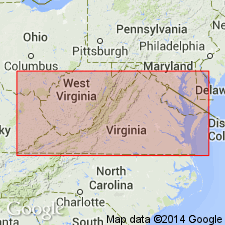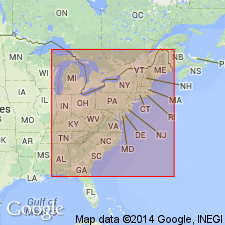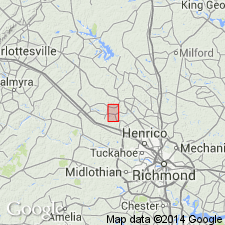
- Usage in publication:
-
- Petersburg granite
- Modifications:
-
- Named
- Dominant lithology:
-
- Granite
- AAPG geologic province:
-
- Piedmont-Blue Ridge province
Jonas, A.I., 1928, Geological map of Virginia; preliminary edition: Virginia Geological Survey
Summary:
Named for Petersburg, Dinwiddie Co., eastern VA. Mapped over a large area including Petersburg. Consists of gray, coarse to fine biotite granite with coarse pink porphyritic facies intruded by fine bluish granite in Fredericksburg, Richmond, and Emporia areas. Age is Precambrian.
Source: GNU records (USGS DDS-6; Reston GNULEX).

- Usage in publication:
-
- Petersburg Granite
- Modifications:
-
- Areal extent
- Revised
- Overview
- AAPG geologic province:
-
- Piedmont-Blue Ridge province
Summary:
Current mapping restricts the Petersburg Granite to a contiguous unit that crops out in the Cities of Richmond and Petersburg. This roughly corresponds to one of four discrete plutons mapped as Petersburg Granite on the 1963 Geologic Map of Virginia. Unit is light- to dark-gray to pink, fine- to coarse-grained, equigranular to porphyritic, foliated to nonfoliated, and ranges from granite to granodiorite in composition. Displays multiple intrusive phases. Contains xenoliths of biotite gneiss and amphibolite. Predominant minerals are quartz, sodic plagioclase, potassium feldspar, biotite, and hornblende. Accessories include ilmenite, magnetite, pyrite, zircon, apatite, titanite, muscovite, and fluorite. Pluton has been dated at 330+/-8 Ma (U-Pb zircon, Wright and others, 1975). Map symbol indicates Mississippian age only.
Source: GNU records (USGS DDS-6; Reston GNULEX).

- Usage in publication:
-
- Petersburg Granite*
- Modifications:
-
- Age modified
- Geochronologic dating
- AAPG geologic province:
-
- Piedmont-Blue Ridge province
Summary:
Petersburg Granite near Richmond has U-Pb zircon age of 330+/-8 Ma (Wright and others, 1975). Smaller bodies near Fredericksburg have U-Pb zircon and Rb-Sr whole-rock ages of 325 to 300 Ma. [Inferred age is Mississippian and Pennsylvanian.]
Source: GNU records (USGS DDS-6; Reston GNULEX).

- Usage in publication:
-
- Petersburg Granite*
- Modifications:
-
- Age modified
- Geochronologic dating
- AAPG geologic province:
-
- Piedmont-Blue Ridge province
Summary:
Age of Petersburg Granite changed to Pennsylvanian based on isotopic age of 314.5+/-2.1 Ma (Lee and Williams, 1993, Microstructural controls on U-Pb mobility in zircons [abs.]: EOS, Transactions, American Geophysical Union, v. 74, no. 43, p. 650-651).
Source: GNU records (USGS DDS-6; Reston GNULEX).
For more information, please contact Nancy Stamm, Geologic Names Committee Secretary.
Asterisk (*) indicates published by U.S. Geological Survey authors.
"No current usage" (†) implies that a name has been abandoned or has fallen into disuse. Former usage and, if known, replacement name given in parentheses ( ).
Slash (/) indicates name conflicts with nomenclatural guidelines (CSN, 1933; ACSN, 1961, 1970; NACSN, 1983, 2005, 2021). May be explained within brackets ([ ]).

